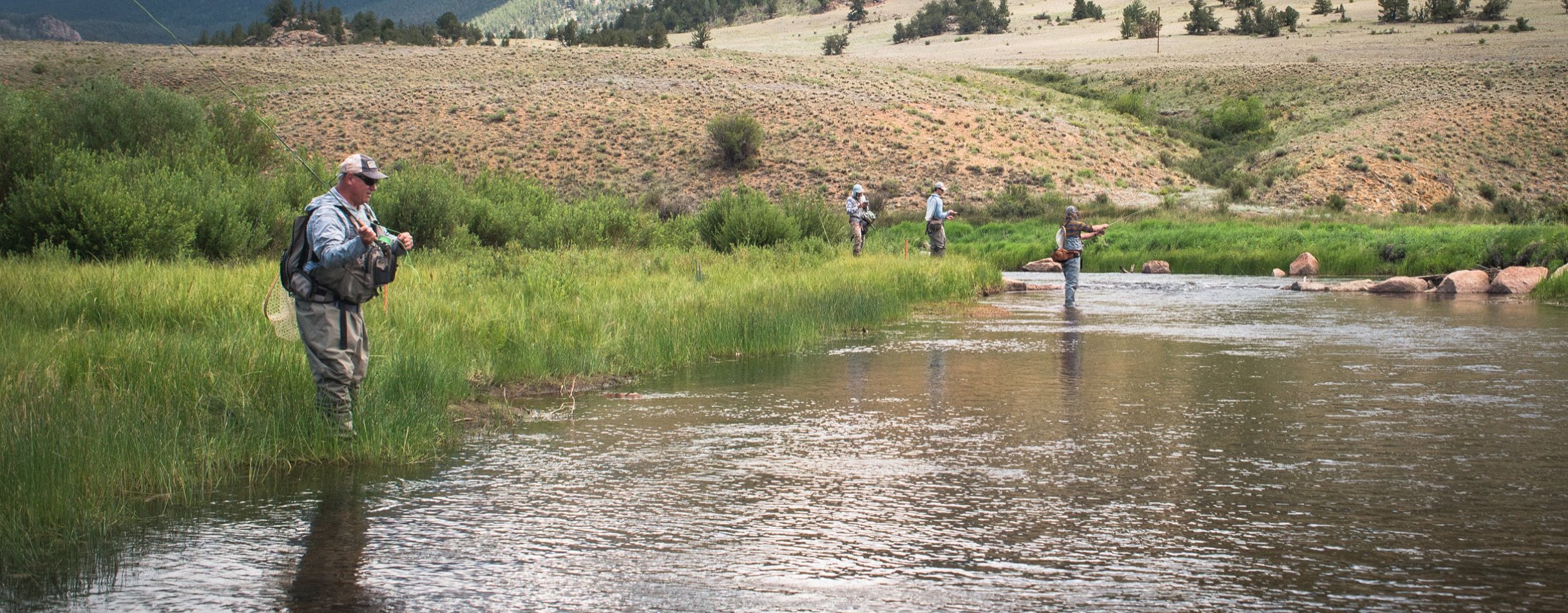
Weekly Report
Note: This report is a part of the FlyCast Lite reporting program and is updated seasonally or in the event of substantial changes that alter fly fishing tactics. FlyCast Lite reports are intended to give anglers a high level overview on seasonal conditions and general fishing tactics.
Tarryall Creek, below the Tarryall Reservoir, has been fairly productive. Stable and healthy flows between 40 and 50 cfs have made for an opportunistic trout. Additionally, bug life has improved dramatically and trout have their pick from a variety of different food sources. As the summer goes on and air temps continue to rise, you’ll want to keep an eye on water temps as they can be dangerous for trout. Regardless, hopper droppers and dry droppers are the name of the game right now. Hit the banks, slack water, slow pools and runs with an Amy’s Ant, Micro Chubby, Elk Hair Caddis or PMX to one or more smaller searchers/attractors or imitative midge, baetis or caddis nymphs and prepare for some looks. If you’re finding that trout are giving you a drive by (take a shot at dry and bail), it probably means you need to downsize or swap flies. Otherwise, be persistent and cover a lot of water. Dry fly rigs are a great option as well. Single or double dry fly rigs or a dry to an emerger will be deadly upon hatch activity.
Recommended Flies
Sub-surface
- Zebra Midge (black/red #18-20)
- Black Beauty #18-20)
- Chocolate Foam Back Emerger (#18-20)
- Stalcup's Baetis (#18-20)
- RS2 (#18-20)
- Darth Baetis (#18-20)
- JuJu Baetis (#18-20)
- Shot Glass Baetis (#18-20)
- Barr's Emerger (#18-20)
- San Juan Worm
- Prince Nymph (#18-20)
- Flashback Pheasant Tail (#18-20)
- Copper John (#18-20)
- Brassie (#18-20)
- Frenchie (#18-20)
- Rainbow Warrior (#18-20)
- Perdigon (#16-18)
Surface
- Parachute Adams (#18-20)
- Matt's Midge (#18-20)
- Griffiths Gnat (#18-20)
- Cluster Midge (#18-20)
- Elk Hair Caddis (#14-18)
- Parachute BWO (#18-20)
- Hi-vis Comparadun (#16-18)
- Micro Chubby Chernobyl (#14-16)
- Amy's Ant (#14-16)
- Hippie Stomper (#14-16)
River Flow
Detailed River Info
Background
Tarryall Creek originates at roughly 11,500 ft on Mount Silverheels and flows southeast into South Park where it meets a number of feeder creeks, most notably Michigan and Jefferson Creek. From South Park, it flows a little over 20 miles into Tarryall Reservoir. Upstream of the reservoir, Tarryall runs through open meadows and predominantly private grazing land. Just below the Tarryall Dam and diversion, the landscape is largely the same. However, it quickly approaches a heavily wooded canyon and steep granite walls. Tarryall Creek offers a variety of small to medium sized rainbow and brown trout, but there are certainly a few lunkers in the 18 to 20 inch variety. Additionally, it is not uncommon to come across wandering pike in the creek on either side of the reservoir.
Angling
The broader Tarryall Creek is most accessible from late spring through early winter. However, the tailwater section below the dam can be fished most of the year. That being said, low winter flows and harsh weather will leave most of the river iced over. In the summer, come prepared with some bug spray as the mosquitos can be relentless. While the nymph rig will produce in the colder months, the dry dropper is our preferred method of fishing most of the year and is particularly effective in the summer and fall. Trout here are not terribly selective and typically have eyes bigger than their stomachs. Meaning, little trout are not shy to hoppers that are half their size.Hatch activity is great particularly in the summer and fall. You can expect to see midges year round as well as BWOs from March to Nov. In the summer and fall, you can expect to see terrestrials, tricos, PMDs, stoneflies and caddis. Small streamers are a solid option too, but can be hit or miss.
River Access
While access is very limited, there are a number of public walk-ins above and below Tarryall Reservoir. Upstream of the reservoir, there are a couple walk-in access points that are clearly marked, one of which is the Tarryall Reservoir State Wildlife area which is about 2 miles northwest of the reservoir. Otherwise, below the dam, there is a quarter mile stretch of public water that offers easy and clear parking. Further southeast, on Highway 77, most of the water is private. However, there are a number of walk-in points at the Ute Creek Trailhead, at the Twin Eagles picnic area/campground and at the Spruce Campground. Beyond that, you enter Pike National Forecast land, but access is difficult. That being said, if you’re up for some “offroading” (4X4 or ATV) and looking for a hike (~2 miles), Forest Road 210 will take you to a trail system where you can access some low pressured water near the confluence of the South Platte.